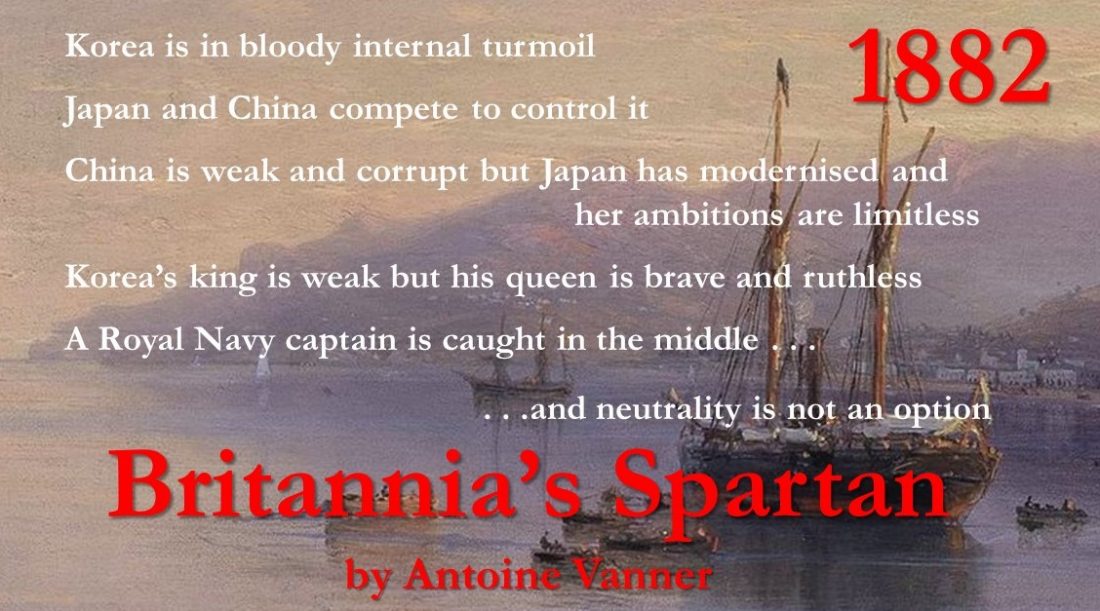More Privateer Action in the Channel: 1799
An earlier article (Click here if you missed it) told of a small vicious action between a British merchant ship and a French privateer in the English Channel at the start of the Revolutionary War in 1793. In the years that followed the pace was not to let up as French privateers, often of very small size, darted out to prey on British coastal traffic and retired quickly to well-defended bases such as Calais. The following account, gain drawing largely on information in the same W. Clark Russell book quoted in the previous article relates to another small-scale but epic battle, this time in 1799, and involving HMS Wolverine.
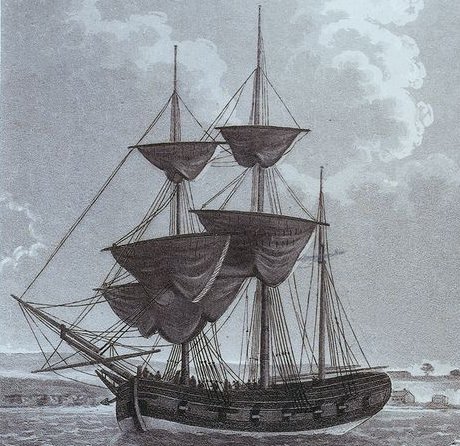
HMS Wolverine 1798 – her rounded bows betray her civilian origin
HMS Wolverine was a civilian-owned collier before being purchased by the Royal Navy in 1798 for conversion to an armed brig. Her armament was powerful – only two of her guns were long 18-pounders and her others were all carronades, six of them 24-pounders and six 12-pounders. The carronades were murderously efficient weapons at short range and gave a craft such as HMSWolverine a “punch” out of all proportion to her size. She was to see service immediately after commissioning by Commander Lewis Mortlock when she supported a “Dieppe 1942” type raid on the port of Ostend.

An armed French lugger of the period
Le Furet and Rusé possibly looked similar
On January 3rd 1799 HMS Wolverine was cruising off the French port of Boulogne, some twenty miles from the English coast. Weather conditions were poor but two large French armed luggers were spotted. These were later identified as the fourteen-gun Le Furet and the eight-gun Rusé, all weapons being four-pounders. Their combined crews were roughly four times the 70 men carried by HMS Wolverine – a potentially decisive factor should it come to boarding. These were typical privateers of the English Channel and such craft usually fled from confrontation with naval units – their objective was capture of rich commercial prizes rather than combat – and Mortlock realised that to bring them to action it would be necessary to play the role of a merchantman, a ruse that HMS Wolverine’s civilian lines would assist. He accordingly hoisted Danish colours and, as expected, the luggers bore down on him and hailed. Asked for his identity, Mortlock answered that he was en-route from Plymouth to Copenhagen. All his guns were manned, their crews out of sight and, to all appearances, HMS Wolverine looked like an unarmed and attractive commercial prize.
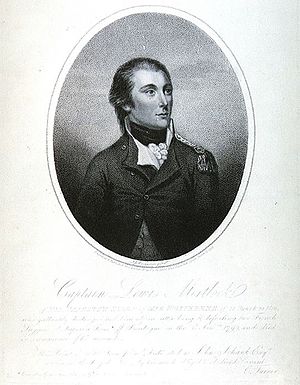
Lewis Mortlock – young, handsome and doomed
Mortlock’s deception paid off. As the unsuspecting Le Furet drew close, British colours were run up in place of the Danish and a full broadside unleashed. Given the disparity in firepower the only French hope now lay in boarding. Le Furet accordingly ploughed on towards HMS Wolverine’s starboard quarter and crashed her bowsprit between the mizzen-shrouds and the mast while small-arms fire were poured on to her decks from the British tops. Close on Le Furet’s heels the Rusé came in on Wolverine’s port bow. From both luggers French boarders now poured across and HMS Wolverine’s gunners had to abandon their weapons to join in the close combat on deck. The four-to one disparity in crew numbers was firmly in favour of the French and the fighting was now of a close, hand to hand, nature. According to Russell’s account, one Frenchman in particular “was observed to be cheering his men and beating them forward with the flat of his sword. The plucky rascal sprung to the top of the round house, where he stood hysterically yelling to his people and flourishing his weapon. Mortlock, supposing him to be the captain of the privateer, rushed at him. The Frenchman snapped a pistol in his face; it missed fire; he drew out another pistol but before he could level it Mortlock had plunged his half-pike into his body and he went overboard.”
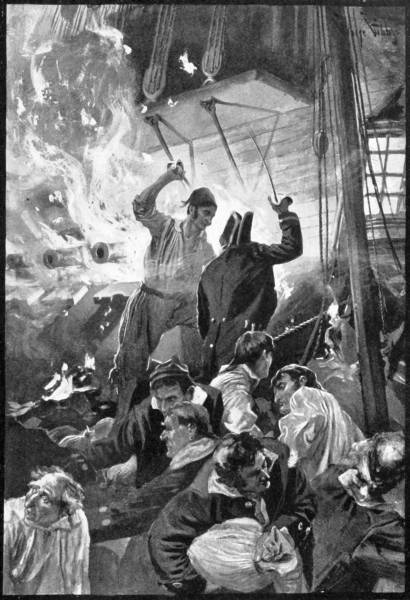
Boarding
The resistance seems to have been so resolute that the French did not press their advantage with any great enthusiasm. A diversion was created by men from Le Furet throwing bags full of incendiary material through HMS Wolverine’s stern windows and starting a fire. This drew the British crew away to fight the conflagration and in the confusion the French boarders withdrew, cut the lashings that bound their luggers to HMS Wolverine, and made off.
HMS Wolverine, scarred but triumphant, retired to Portsmouth.
Reading of such close actions one is often struck by how light the casualties could be. HMS Wolverine lost two men, one of them Commander Mortlock, who had been badly wounded. He died in his mother’s arms a week later and his funeral was attended by every captain then in Portsmouth. A touching footnote is that his Newfoundland dog, who had been on board HMS Wolverine throughout the action, survived unscathed. One hopes that he had a long and happy life thereafter.
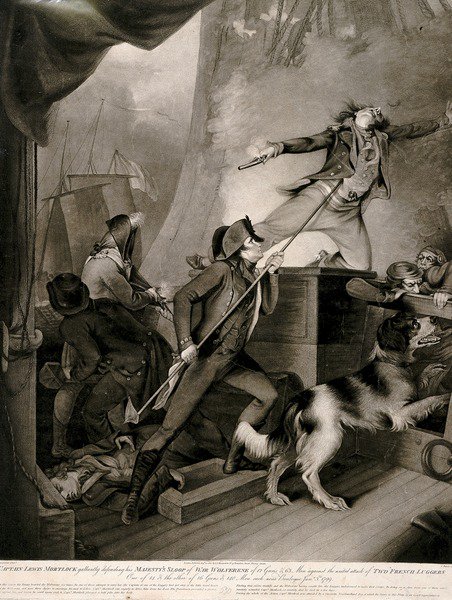
Mortlock and his dog on HMS Wolverine
French losses were heavier – a total of nineteen killed or dying of wounds shortly afterwards, plus many wounded who survived. Among the dead were Le Furet’s captain – possibly the “plucky rascal” whom Mortlock had slain – and three officers from the Rusé. The disproportion in losses may be partly explained by the surprise that HMS Wolverine unleashed on her unsuspecting attackers and another factor is almost certainly that the British crew’s stricter discipline and better training made them more effective than the privateersmen.
Commander Lewis Mortlock’s name is a forgotten one today, yet he was one of the thousands of brave, promising, splendid men whose professionalism was to save Britain and Europe from French domination. We owe him, and those like him, a debt.
Naval fiction enters the Age of Fighting Steam
Since its original publication, the Dawlish Chronicles novel Britannia’s Spartan has consistently scored 5-star reviews
For more details, click on the image below
The Dawlish Chronicles – now up to eight volumes, and counting …
A sixth free short-story, Britannia’s Rescuers, set in 1875, is now available for download (with five others) to your Kindle. Access it by registering for the Dawlish Chronicles mailing list – just click on the banner below. You’ll be kept updated on new books and it facilitates e-mail contact between Antoine Vanner and his readers.

